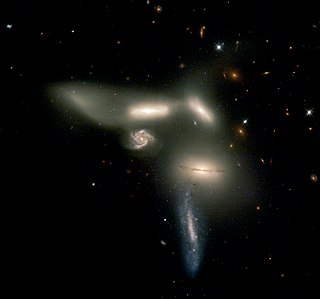
Seyfert's Sextet is a group of galaxies about 190 million light-years away in the constellation Serpens. The group appears to contain six members, but one of the galaxies, NGC 6027d, is a background object and another "galaxy," NGC 6027e, is actually a part of the tail from galaxy NGC 6027. The gravitational interaction among these galaxies should continue for hundreds of millions of years. Ultimately, the galaxies will merge to form a single giant elliptical galaxy.

Stephan's Quintet is a visual grouping of five galaxies of which four form the first compact galaxy group ever discovered. The group, visible in the constellation Pegasus, was discovered by Édouard Stephan in 1877 at the Marseille Observatory. The group is the most studied of all the compact galaxy groups. The brightest member of the visual grouping is NGC 7320, which has extensive H II regions, identified as red blobs, where active star formation is occurring.
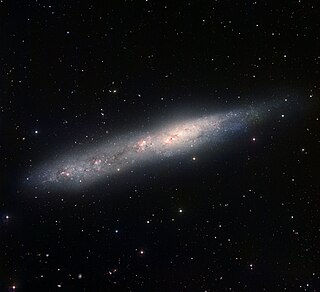
NGC 55, is a Magellanic type barred spiral galaxy located about 6.5 million light-years away in the constellation Sculptor. Along with its neighbor NGC 300, it is one of the closest galaxies to the Local Group, probably lying between the Milky Way and the Sculptor Group. It has an estimated mass of (2.0 ± 0.4) × 1010M☉.

The Leo Triplet is a small group of galaxies about 35 million light-years away in the constellation Leo. This galaxy group consists of the spiral galaxies M65, M66, and NGC 3628.
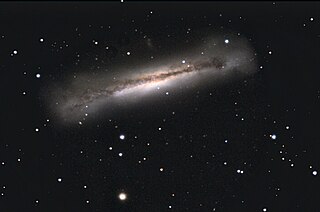
NGC 3628, also known as the Hamburger Galaxy or Sarah's Galaxy, is an unbarred spiral galaxy about 35 million light-years away in the constellation Leo. It was discovered by William Herschel in 1784. It has an approximately 300,000 light-years long tidal tail. Along with M65 and M66, NGC 3628 forms the Leo Triplet, a small group of galaxies. Its most conspicuous feature is the broad and obscuring band of dust located along the outer edge of its spiral arms, effectively transecting the galaxy to the view from Earth.
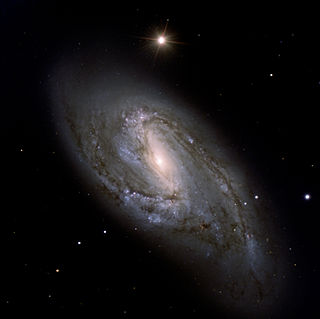
Messier 66 or M66, also known as NGC 3627, is an intermediate spiral galaxy in the southern, equatorial half of Leo. It was discovered by French astronomer Charles Messier on 1 March 1780, who described it as "very long and very faint". This galaxy is a member of a small group of galaxies that includes M65 and NGC 3628, known as the Leo Triplet or the M66 Group. M65 and M66 are a common object for amateur astronomic observation, being separated by only 20′.

NGC 7320 is a spiral galaxy in Stephan's Quintet. However, it is not an actual member of the galaxy group, but a much closer line-of-sight galaxy at a distance of about 40 million light years, the same as the nearby NGC 7331. Other galaxies of Stephan's Quintet are some 300 million light-years distant.

Robert's Quartet is a compact galaxy group approximately 160 million light-years away in the constellation Phoenix. It is a family of four very different galaxies whose proximity to each other has caused the creation of about 200 star-forming regions and pulled out a stream of gas and dust 100,000 light years long. Its members are NGC 87, NGC 88, NGC 89 and NGC 92, discovered by John Herschel on the 30 September 1834.

NGC 7331, also known as Caldwell 30, is an unbarred spiral galaxy about 40 million light-years (12 Mpc) away in the constellation Pegasus. It was discovered by William Herschel in 1784. NGC 7331 is the brightest galaxy in the field of a visual grouping known as the NGC 7331 Group of galaxies. In fact, the other members of the group, NGC 7335, 7336, 7337 and 7340, lie far in the background at distances of approximately 300-350 million light years.
A Hickson Compact Group is a collection of galaxies designated as published by Paul Hickson in 1982.

NGC 247 is an intermediate spiral galaxy about 11.1 Mly away in the constellation Cetus. This distance was confirmed in late February 2011. Previous measurements showed that the galaxy was about 12.2 Mly away, but this was proved to be wrong. NGC 247 is a member of the Sculptor Group, and is 70 000 light years in diameter.

NGC 2552 is a Magellanic spiral galaxy located some 22 million light years away. It can be found in constellation of Lynx. This is a type of unbarred dwarf galaxy, usually with a single spiral arm. It is inclined by 41° to the line of sight from the Earth along a position angle of 229°. The measured velocity dispersion of the stars in NGC 2552 is relatively low—a mere 19 ± 2 km/s. This galaxy forms part of a loose triplet that includes NGC 2541 and NGC 2500, which together belong to the NGC 2841 group.

NGC 5668 is a nearly face-on spiral galaxy, visual magnitude about 11.5, located about 81 million light years away in the constellation Virgo. It was discovered in 1786 by William Herschel. It is a member of the NGC 5638 Group of galaxies, itself one of the Virgo III Groups strung out to the east of the Virgo Supercluster of galaxies.

NGC 6845 is an interacting system of four galaxies in the constellation Telescopium. The cluster has certain similarities with Stephan's Quintet. Its distance is estimated to be about 90 Mpc.

A galaxy group or group of galaxies (GrG) is an aggregation of galaxies comprising about 50 or fewer gravitationally bound members, each at least as luminous as the Milky Way (about 1010 times the luminosity of the Sun); collections of galaxies larger than groups that are first-order clustering are called galaxy clusters. The groups and clusters of galaxies can themselves be clustered, into superclusters of galaxies.

NGC 3718, also called Arp 214, is a galaxy located approximately 52 million light years from Earth in the constellation Ursa Major. It is either a lenticular or spiral galaxy.

The Copeland Septet is a group of galaxies in the constellation Leo that includes NGC 3748, NGC 3754, NGC 3750, NGC 3751, NGC 3745, NGC 3753 and NGC 3746. The group was discovered by British astronomer Ralph Copeland in 1874. The location of Copeland's Septet is right ascension 11h 37m 50s / declination +21° 59′ (2000.0), about three degrees northwest of third magnitude star 93 Leonis.
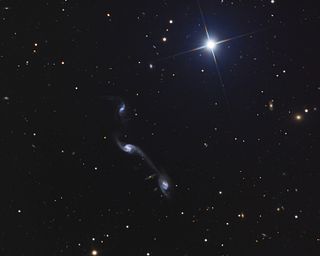
Wild's Triplet is a group of three small, interacting spiral galaxies. The galaxies are visible in the constellation Virgo. The triplet has luminous connecting bridges and is located some 200 million light-years away. The aforementioned bridges are probably formed as a result of gravitational tidal interactions among the galaxies. The triplet is named after the British-born and Australia-based astronomer Paul Wild (1923–2008), who studied the trio in the early 1950s.
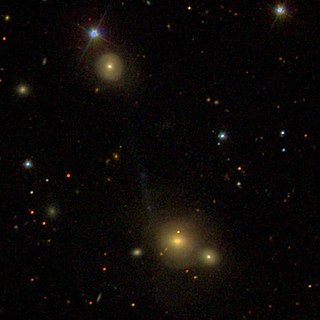
Zwicky's Triplet is a group of three galaxies visible in the constellation Hercules.


















